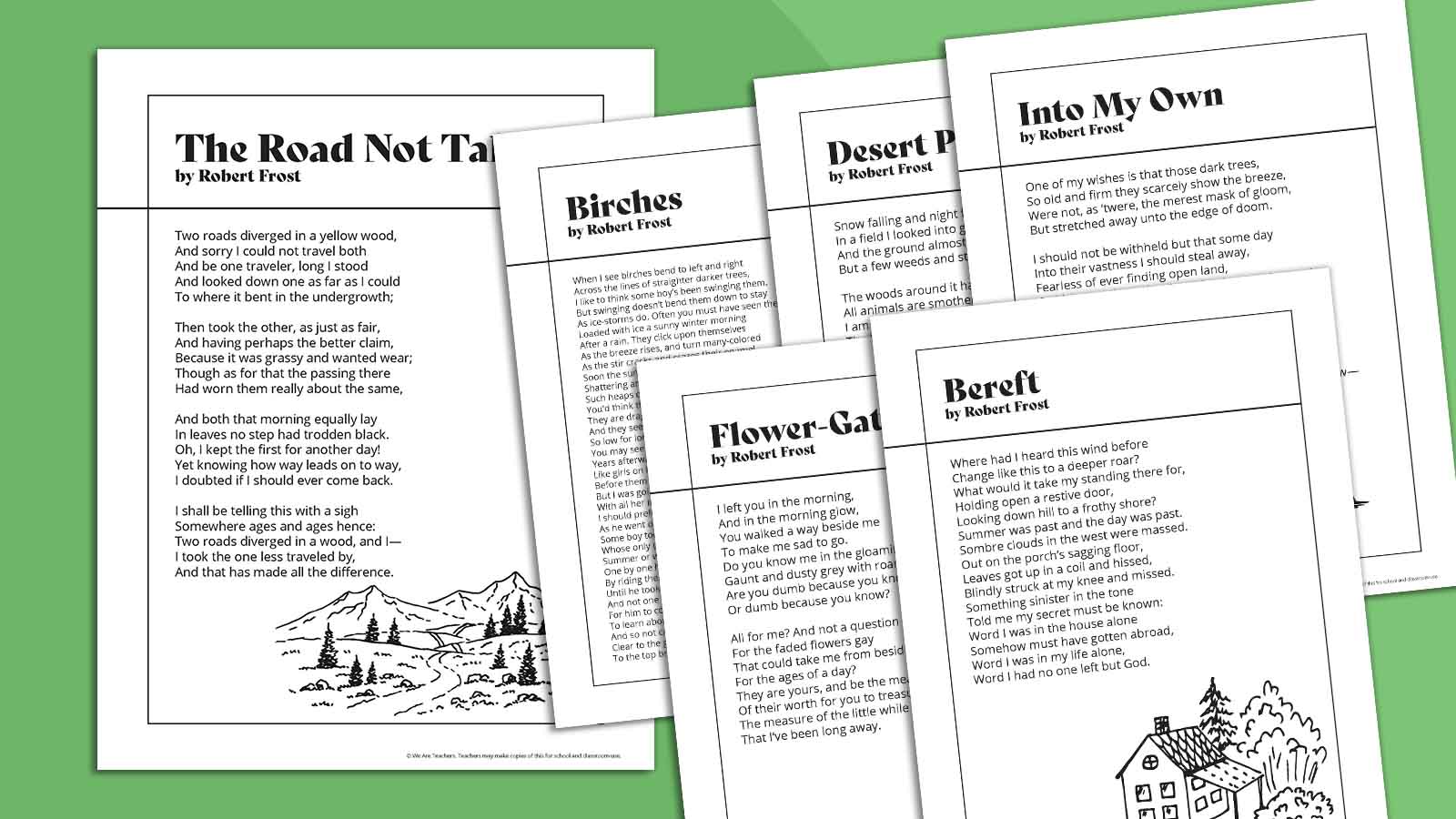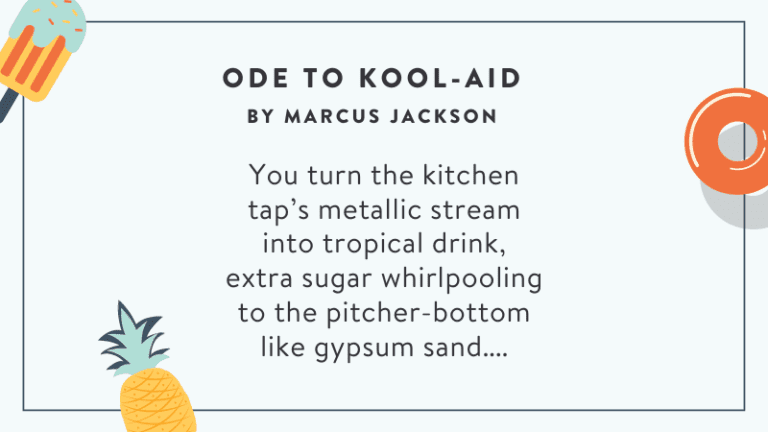Say the name Robert Frost and you can practically hear trees swaying and snow falling. Robert Frost (1874-1963) is best known for his poems about nature that meditate both on the natural world and our place in it, but he’s written more than 100 poems about everything from youth and aging to narratives about life in rural America to how our feelings can change in an instant.
Given his range and memorable imagery, it’s no surprise that Frost is one of the greatest American poets of the 20th century. Interestingly, he was not part of any particular movement, like modernism or traditionalism. Some of Robert Frost’s poems are long and evocative, while others are short and pithy. Frost is a great poet to teach because he used poetry to write stories, explore deep human emotion, and create rich descriptive scenes.
These 25 Robert Frost poems are among his best. They show his range in topic, theme, and craft.
Get the full text of each poem as a free printable to use with your students by filling out the form on this page.
Famous Robert Frost Poems
The Road Not Taken
Two roads diverged in a wood, and I—
I took the one less traveled by,
And that has made all the difference.
“The Road Not Taken” is by far the best known of Frost’s poems, so much so that it’s become a cliché. He wrote it in 1916 as the opening poem in his book Mountain Interval. The poem has been analyzed by many students and critics, and there is debate about what the “road less traveled” actually means. This poem is a great starting point for a unit on Frost as it gives students a chance to discuss Frost’s language and themes, exposes them to Frost’s poetry that touches on nature, and allows them to read multiple analyses of one poem.
Mending Wall
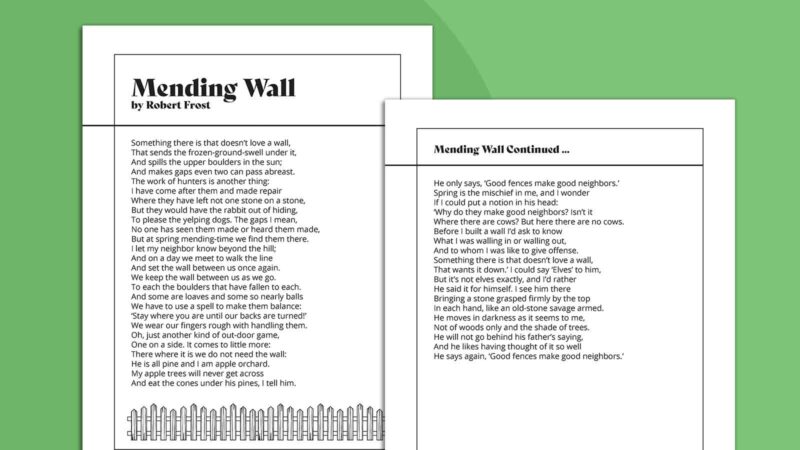
He will not go beyond his father’s saying,
And he likes having thought of it so well
He says again, “Good fences make good neighbors.”
“Mending Wall” is another of Frost’s famous poems. It’s about humans’ urge to leave our mark and for setting boundaries for houses and gardens. It’s also about relationships and how they develop. Students can discuss what Frost meant with the line “Good fences make good neighbors” when he wrote it and what it means now. Interestingly, before he died, Frost observed that many people have misinterpreted the poem, but he also did not reveal what he meant when he wrote it.
Stopping by Woods on a Snowy Evening
Whose woods these are I think I know.
His house is in the village though;
He will not see me stopping here
To watch his woods fill up with snow.
If “The Road Not Taken” is Frost’s best-known poem, “Stopping by Woods on a Snowy Evening” is the most loved of Frost’s poems. The poem reads like a journal entry because it was inspired by an evening when Frost stopped by the woods on his way home. It’s a great entrance into Frost’s work and a wonderful example of how poets can create atmosphere with their words.
Birches
When I see birches bend to left and right
Across the lines of straighter darker trees,
I like to think some boy’s been swinging them.
“Birches” takes a look at how birch tree branches get bent in a blank-verse meditation on the fun of swinging from trees, and how they get bent in a storm. This poem is also a glimpse into Frost’s biography as it was inspired by his childhood memories of swinging on tree branches.
Fire and Ice
Some say the world will end in fire,
Some say in ice.
From what I’ve tasted of desire
I hold with those who favor fire.
“Fire and Ice” is one example of Frost’s versatility. It’s only nine lines long, but it packs a punch and was reportedly the inspiration for George R.R. Martin’s epic A Song of Ice and Fire. Talk with students about the imagery in the poem and the scenarios Frost imagines. Also, talk about the various ways this poem could be interpreted, line by line.
Mowing
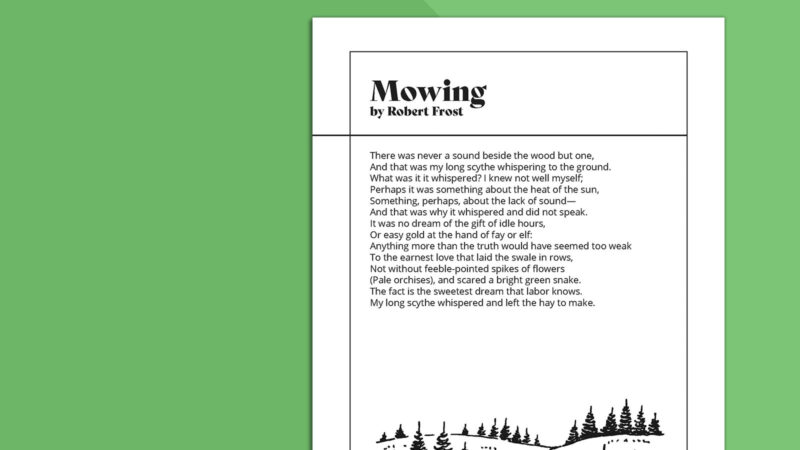
The fact is the sweetest dream that labor knows.
My long scythe whispered and left the hay to make.
Frost explores many everyday topics, like working, in his poetry. “Mowing” is about the act of mowing grass with a scythe. Use this poem to talk about what Frost thought about hard work, and how he took one activity—mowing—and delved into each sensory description.
Acquainted With the Night
I have been one acquainted with the night.
I have walked out in rain—and back in rain.
I have outwalked the furthest city light.
Most of Frost’s poems are about country and rural experiences, which makes “Acquainted With the Night” unique since it’s about urban life. This sonnet-like poem can be compared with other Frost poems about observations while walking. It’s also an accessible poem for students who are new to analyzing poetry.
Desert Places
Snow falling and night falling fast, oh, fast
In a field I looked into going past,
And the ground almost covered smooth in snow,
But a few weeds and stubble showing last.
“Desert Places” is a poem to review alongside “Stopping by Woods on a Snowy Evening.” In this poem, Frost goes deeper into the isolation we feel as humans and uses snow to set the scene.
The Freedom of the Moon
I’ve tried the new moon tilted in the air
Above a hazy tree-and-farmhouse cluster
As you might try a jewel in your hair.
In “The Freedom of the Moon,” Frost uses figurative language to describe his experience and uses descriptions of the moon to create an extended metaphor about freedom. Use this poem for a close reading that explores how to analyze a poem on multiple levels across multiple sessions.
To Earthward
Love at the lips was touch
As sweet as I could bear;
And once that seemed too much;
I lived on air
“To Earthward” explores the topic of aging and how aging changes the speaker’s connection to Earth. The narrator searches out pain, not pleasure, as he gets older. It is a discussion of how we feel a range of emotions as we grow older.
The Wood-Pile
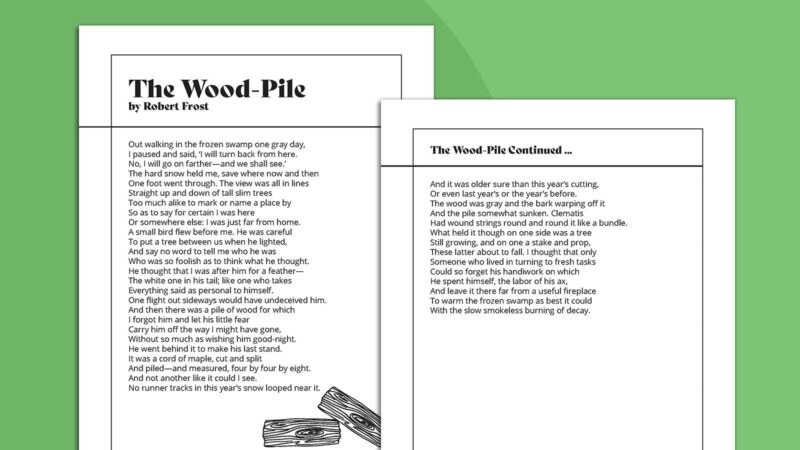
He spent himself, the labor of his ax,
And leave it there far from a useful fireplace
To warm the frozen swamp as best it could
With the slow smokeless burning of decay.
“The Wood-Pile” is another evocative poem about discovering nature, this time, the discovery of a wood-pile. Use this poem with other Frost poems to compare how Frost explores a walk in the woods, discovery, and emotion.
Tree at My Window
Tree at my window, window tree,
My sash is lowered when night comes on;
But let there never be curtain drawn
Between you and me.
In “Tree at My Window,” Frost narrows in on one tree that he can see outside his window and how he feels about it. This poem could be a good starting point for students to create their own detail-oriented observation poems.
Gathering Leaves
Spades take up leaves
No better than spoons,
And bags full of leaves
Are light as balloons.
“Gathering Leaves” is another short but profound poem with themes of man versus nature and change.
The Death of the Hired Man
Mary sat musing on the lamp-flame at the table
Waiting for Warren. When she heard his step,
She ran on tip-toe down the darkened passage
To meet him in the doorway with the news
“The Death of the Hired Man” is a well-known poem because of how Frost develops the character and narrative through poetic techniques. This poem will show students just how varied one poet can be in their writing.
The Trial by Existence
Even the bravest that are slain
Shall not dissemble their surprise
On waking to find valor reign,
Even as on earth, in paradise
“The Trial by Existence” is a classic Frost poem. It touches on his common themes of what it means to be human, life’s complexities, and how we make choices. It also includes the imagery, metaphors, and tone that are classic Frost. Use this poem either to introduce students to Frost or as a final analysis exercise where they can combine all their knowledge of Frost into one poem analysis.
Come In
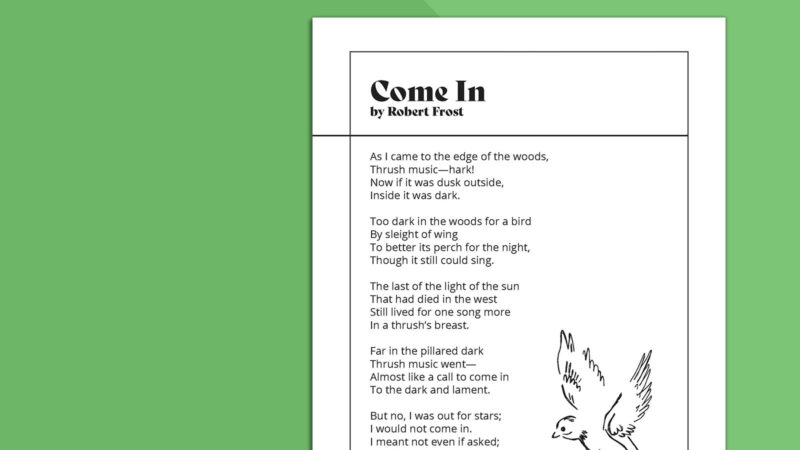
As I came to the edge of the woods,
Thrush music—hark!
Now if it was dusk outside,
Inside it was dark.
“Come In” looks at how we project ourselves onto nature, capturing both the visual and emotional experiences.
Bereft
Where had I heard this wind before
Change like this to a deeper roar?
“Bereft” is a personal poem that explores changes in Frost’s life and how he felt in the moment.
Blue-Butterfly Day
It is blue-butterfly day here in spring,
And with these sky-flakes down in flurry on flurry
There is more unmixed color on the wing
Than flowers will show for days unless they hurry.
“Blue-Butterfly Day” describes a flock of butterflies as a metaphor for the cycle of life and death.
A Prayer in Spring
Oh, give us pleasure in the flowers to-day;
And give us not to think so far away
As the uncertain harvest; keep us here
All simply in the springing of the year.
“A Prayer in Spring” is a request for peace in the midst of a stressful world, a relatable theme for students today.
Dust of Snow
The way a crow
Shook down on me
The dust of snow
From a hemlock tree
Has given my heart
A change of mood
And saved some part
Of a day I had rued.
“Dust of Snow” captures a change in mood through one experience in nature: snowfall. It’s a good poem for line-by-line analysis.
For Once, Then, Something
One drop fell from a fern, and lo, a ripple
Shook whatever it was lay there at the bottom,
Blurred it, blotted it out. What was that whiteness?
“For Once, Then, Something” starts with a man looking into a well from the wrong side and ends with thoughts on the search for truth and inability to see below the surface. This is a good poem to analyze how Frost uses poetry to meditate on an idea.
Home Burial
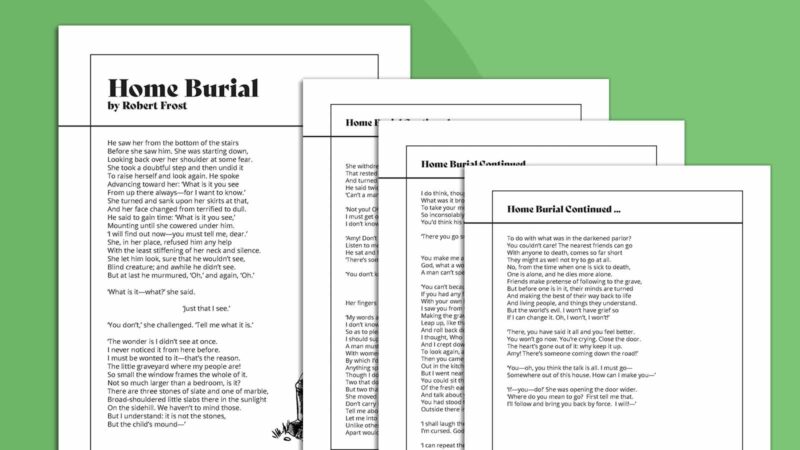
He saw her from the bottom of the stairs
Before she saw him. She was starting down,
Looking back over her shoulder at some fear.
Many of Frost’s poems evoke stillness and quiet, but “Home Burial” is about grief. The story is of a mother grieving her son and the conflicts with her husband. With Frost’s word choice and imagery, it’s a deep, emotional text.
Into My Own
One of my wishes is that those dark trees,
So old and firm they scarcely show the breeze,
Were not, as ’twere, the merest mask of gloom,
But stretched away unto the edge of doom.
Another poem on the theme of aging and maturity, “Into My Own” is about childhood and exploring oneself—a good theme for middle and high schoolers.
Out, Out—
The buzz saw snarled and rattled in the yard
And made dust and dropped stove-length sticks of wood,
Sweet-scented stuff when the breeze drew across it.
“Out, Out—” is a poem that will stay with students. The narrative is of a young boy who has a terrible accident when severing his hand with a buzz saw. The imagery and how Frost handles the topic create images that linger long after the poem is read. For students who think that poetry is all description and love sonnets, this poem will show them that’s not the case.
Flower-Gathering
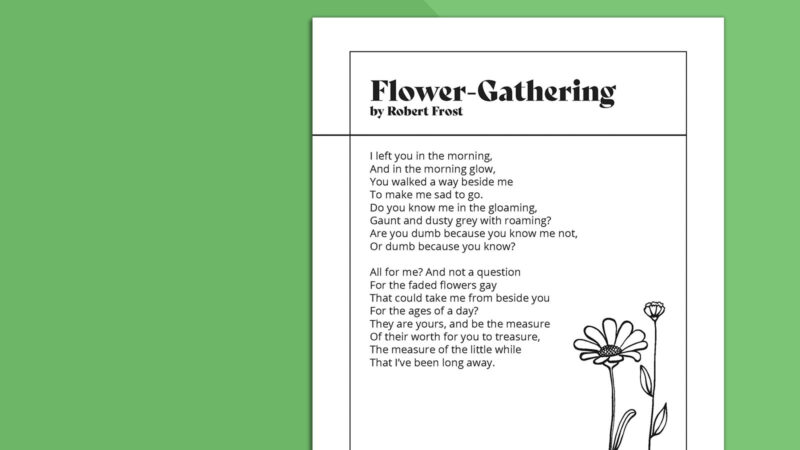
I left you in the morning,
And in the morning glow,
You walked a way beside me
To make me sad to go.
Flower-Gathering is another poem about nature, but this time Frost takes a different perspective on his walks in nature. He takes a more metacognitive approach, describing the walk as a way to get inspiration for his poetry. He also writes about his wife, Elinor.
Get free printables of all of these Robert Frost poems!
Share your email address for instant access to full-text printable versions of all the Robert Frost poems on this list.
